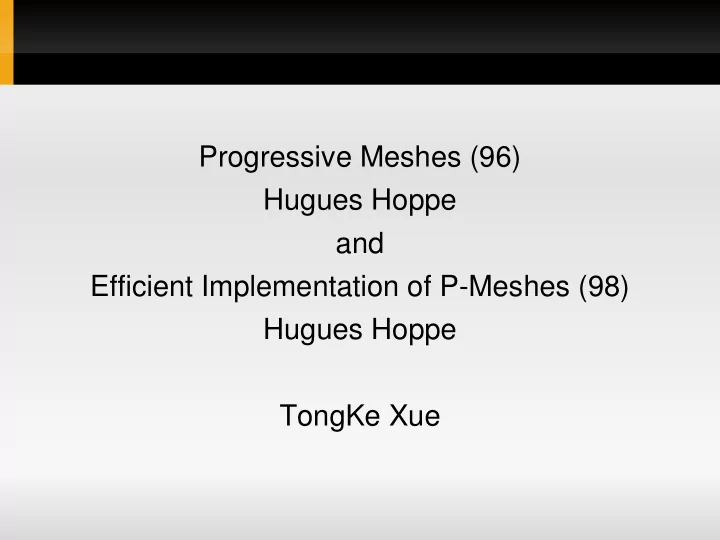

Progressive Meshes (96) Hugues Hoppe and Efficient Implementation of P-Meshes (98) Hugues Hoppe TongKe Xue
Problems with Large Meshes Expensive to store Expensive to transmit Exprensive to renders --> Motivates new problems
Motivated Problems Mesh simplification Level-of-detail approximation smooth geomorphs Progressive transmission Mesh compression Selective refinement
'96 paper claims ... Novel progressive mesh representation; progressive transmission; concise encoding: probably true Selective refinement questionable; requires an (elegant) hack not in the paper Novel simplification procedure seems very hackey (in the bad sense)
Table of Contents General Idea + What P-Meshes provide How to Store Efficiently / Compression How to Construct P-Meshes
Idea 1 (Limitation 1) Limit ourselves to: edge collapse operations New vertex is either old, new, or avg(old, new)
Idea 2 (Iterate!) M = original model; construct a series of models M=M_0, M_1, M_2, .... M_n=M* where from M_k to M_{k+1}, we kill a single edge M* = coarse model; store the diffs between M_k as M_{k+1} as vertex splits
Important Detail A vertex split (inverse of edge collapse) consists of: (s, l, r, t, A) We add a vertex t near an (existing) vertex s , adding faces stl and tsr , and update some attributes (color, texture, shader, ...) with A vertex split == diff
Free Features 1 Progressive Transmission Send M* ... then send the diffs later Smooth Geomorphing: We're just adding in verticies; easy to linearly interpolate diffs Draw on white board Mesh Compression discussed later
Selective Refinement We don't have to apply the diff's in order for a (s, l, r, t, A) vsplit, if l, r, and s are already there ... we can use it if l or r are not there, but their 'closest-living- ancestor' are adjacent to s , then we can pseudo-apply ugly detail not mentioned in paper: we can still guarantee same mesh in the end
Movies!
Table of Contents General Idea + What P-Meshes provide How to Store Efficiently / Compression How to Construct P-Meshes
Faces, Wedges, Corners
vsplit structure
efficient vertex split
corners
ii
'Standard' Mesh
PMesh
M vs M_0
iteration / space requirements
vsplit fields (slightly lossy)
approximate/restrict more
Table of Contents General Idea + What PM's provide How to Store Efficiently / Compression How to Construct P-meshes This can be done better.
'related' background from his 93 paper simulated annealing / energy like
actual energy function 'scalar' to minimize scalar changes; disc to ensure discontinuities aren't eliminated throw all edges on a priority queue + pop
E_{dist} + E_{spring} Claims can't be evaluated efficiently. Possible leftover from mesh optimization (93):
E_{scalar} optimizes only for scalar values at vertices / corners claims this works for (r,g,b) values after clipping for normals: just interpolates
E_{disc} discontinuity curves defined by material boundaries / large changes in corner scalar attributes sample additional set of points on discontinuity curve; penalize for distance away from curve
E_{disc} example
Discussion
Recommend
More recommend